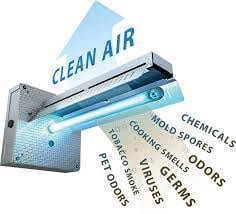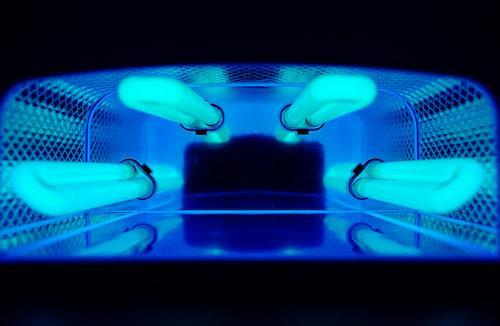The world around us is full of germs. While wiping down surfaces and washing hands takes care of a lot of the bacteria we encounter, these measures aren’t effective against airborne bacteria and viruses. We need a solution that purifies the air in our environments so we can breathe easy – literally and figuratively.
UV light is a common tool used to kill airborne bacteria and viruses
When it comes to air purification, UV light is a common tool used to kill airborne bacteria and viruses. When UV light encounters microbes, it disrupts their DNA so they can’t multiply. We are exposed to UV light all the time from the sun. While the sun produces UVA, UVB, and UVC light, only UVA and UVB reach earth since UVC is not able to penetrate the earth’s atmosphere. When you get a sunburn, it’s due to the roughly 5% of UVB light that passes through the atmosphere. However, we can still encounter UVC light by artificial means.
When UV light is used for air purification, it is typically artificial UVC, which has the shortest wavelength, and thus the most energy. UVA and UVB encompass other wavelength spectrums and are naturally generated from the sun.
It’s important to note, however, that using light for air purification isn’t a perfect solution as there are significant drawbacks when it comes to your budget and the health of the building’s occupants. When using UV light, you should consider the damage to eyes if people look directly into it. And you should consider ozone exposure which can negatively affect people’s lungs and breathing. Another factor to consider is the maintenance of the UV lights. The bulbs are cumbersome to clean and costly to replace.
History of UV light for air purification
UV light has been used for air purification since 1877 when two scientists observed that exposure to the sun prevented the growth of microorganisms in test tubes. Those two scientists, Downes and Blunt, went on to discover that the ability to inhibit growth was related to intensity, duration of exposure, and wavelength.
Later, it was discovered that different organisms reacted to the light differently. Thus, the level of UV exposure required to kill a microorganism varied. Specifically, in 1890 researchers discovered that the tubercle bacillus (TB) virus was particularly sensitive to UV light. This is significant because in the 1980s when TB was making a comeback in the US, many turned to UV lights for preventative measures.
In the 1930s, scientist William F. Wells determined that viruses could become airborne when an infected person coughed or sneezed. He began to test the use of UV lights to purify the air in highly contagious areas, namely hospital surgery rooms, and children’s wards. His experimentation was highly successful in reducing the number of infections and was quickly adopted by other hospitals around the country.
With the advent of immunization against diseases such as measles and TB, the use of UV lights fell out of favor. As alluded to above, in the 1980s, UV lights were brought back into the picture as one part of the plan to fight the rising TB cases.
Through decades of experimentation, it was determined that, while some surface decontamination is likely, UV lights work best against airborne droplets rather than direct contact purification.
UV lights today
 Today, most uses of UV air purification fall into two major categories: Upper Room and In-Duct application. Industrial spaces with high ceilings can benefit from using Upper Room techniques. In-Duct applications work better for places that have lower ceiling heights and central air systems.
Today, most uses of UV air purification fall into two major categories: Upper Room and In-Duct application. Industrial spaces with high ceilings can benefit from using Upper Room techniques. In-Duct applications work better for places that have lower ceiling heights and central air systems.
Upper Room disinfection is made for use in occupied rooms without needing any personal protection. It primarily works by forcing an upward draft of air using an HVAC system. The UV light is wall mounted at the top of the room to interact with rising air and eliminate any harmful organisms. Since the virus or bacteria must come into direct contact with the UV light, the upward flow of air is critical for the effectiveness of this type of application.
An in-duct application works by placing the UV light in the air duct of the HVAC system. This application relies on all of the air that flows into the room to pass by the installed UV lights, thus eradicating any harmful germs.
It is important to note that with both of these systems, the air needs to make multiple passes in front of the light to be considered pure. The duration required to eliminate viruses and bacteria is dependent upon each organism. The bottom line is, what may work to eliminate one virus may not work for another virus.
Learn more about other air purification technologies
Things to consider when choosing UV lights
A potential drawback is UV lights can be harmful if not used correctly. Some potential hazards to be aware of include direct contact/interaction and ozone.
In the same way that looking at the sun directly can damage your eyes, looking directly at a UV light can affect your vision. In fact, since UV lights tend to isolate the UV-C wavelength, the light itself has more energy and thus could be more harmful. If you choose to install a UV light in your building, it must be out of direct eye contact to prevent damage.
In addition, some UV lights emit ozone. When inhaled, ozone can damage the lungs. Even relatively low amounts can cause chest pain, coughing, shortness of breath, and throat irritation. Different people react in different ways to ozone exposure. But this should be taken into consideration if purchasing.
Conclusion
While UV lights have a long history of use, the hazards associated with them shouldn’t be taken lightly. Proceed with caution if you decide to go this route for your air purification needs.
Airius PureAir fans use ionization technology [link to ion blog] to provide a safe, continuous flow of clean air. Available in many sizes, the PureAir is effective at combating airborne pathogens and keeping your customers and employees safe, healthy, and comfortable. Talk with one of our PureAir experts today.




Leave A Comment
You must be logged in to post a comment.